Casco Antiguo de Qingyan - Entradas, horarios, ubicación y puntos destacados
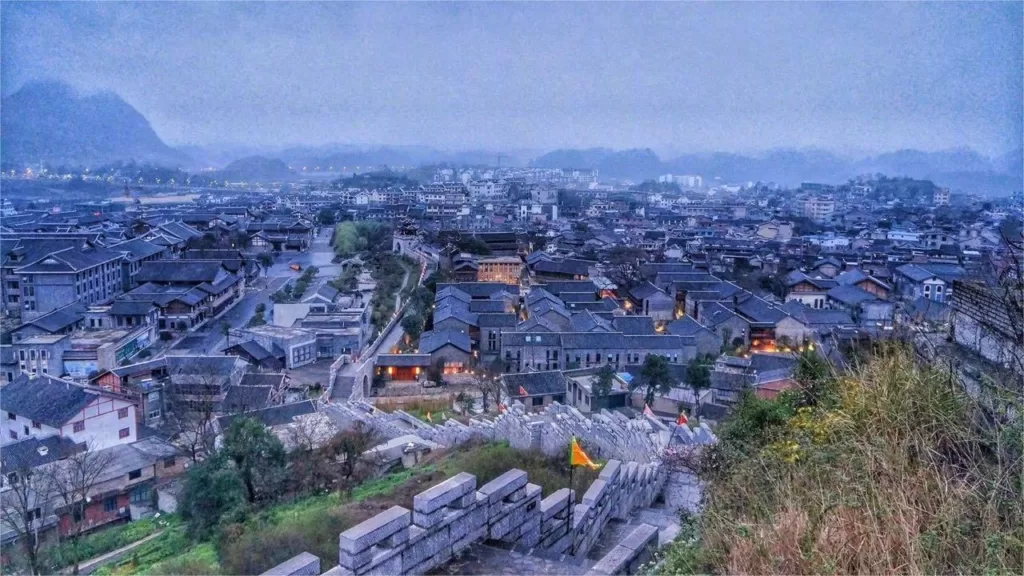

Qingyan Ancient Town (青岩古镇), situated in the southern suburbs of Zhenyuan, Bing’an, and Longli. Originating from the Ming Dynasty, the town was initially established as a military fortress. Over the years, it has meticulously preserved a plethora of ancient buildings from the Ming and Qing periods, gaining widespread recognition, especially after being featured in the film “Search for the Gun.”
Nestled against the mountainside, Qingyan Ancient Town boasts well-preserved city walls constructed with colossal stones perched on cliffs. It is fortified with four gates facing east, west, south, and north. One of the town’s highlights is the exquisite craftsmanship displayed in the stone and wood carvings found throughout its architecture. The intricate details of these carvings contribute to the town’s aesthetic charm.
Religious diversity is another aspect of Qingyan, where Buddhism, Taoism, Catholicism, and Christianity coexist. Notable landmarks include a Christian church and a Catholic cathedral, adding to the town’s cultural and religious richness.
While the town is primarily adorned with various styles of ancient architecture, each attraction within Qingyan Ancient Town has its own entrance fee. Visitors, especially those exploring for the first time, may opt for a combined ticket to access all the scenic spots within the ancient city. Alternatively, those seeking a leisurely day within the ancient city can choose to purchase tickets selectively based on their preferences. Whether appreciating the craftsmanship, exploring religious sites, or capturing the essence of the backstreet, Qingyan Ancient Town offers a delightful journey through time and culture.
Índice
- Información básica
- Ubicación y transporte
- History of Qingyan Ancient Town
- Highlights of Qingyan Ancient Town
- Vlog about Qingyan Ancient Town
- Consejos útiles resumidos a partir de reseñas
- Otras atracciones del distrito de Huaxi
Información básica
| Duración estimada de la visita | 1 día |
| Precio combinado de las entradas | 60 RMB |
| Horario de apertura | 8.00 – 21.30 |
| Horario de apertura | 0086-400-116-9666 |
Ubicación y transporte
Qingyan Ancient Town is nestled in the southern part of Huaxi District, approximately 29 kilometers south of the central urban area of Guiyang, the capital city of Guizhou Province. It is also situated about 12 kilometers away from the Huaxi urban area. To reach Qingyan Ancient Town, visitors have several convenient options:
- Direct Shuttle Bus from Qianling Mountain Park:
- Board the dedicated shuttle bus at Qianling Mountain Park.
- The route passes through Tianhetan and concludes at the West Gate of Qingyan Ancient Town.
- From Guiyang Longdongbao International Airport:
- Opt for Airport Bus Line 5.
- Board the bus at platform 5, and after passing several stops, it will arrive at Qingyan Ancient Town (West Gate).
- From Guiyang Railway Station:
- Take Bus 203:
- Board the bus directly at Guiyang Railway Station.
- After approximately 39 stops, it reaches Qingyan Ancient Town (West Gate).
- Take Bus 225:
- Board Bus 225 at Guiyang Railway Station.
- After 6 stops, transfer to Bus 210 at Xiabacun.
- Continue for another 21 stops to reach Qingyan Ancient Town (West Gate).
- Directly choose Bus 210:
- Board Bus 210 from Huaguoyuan.
- The bus travels directly to the West Gate of Qingyan Ancient Town.
- Take Bus 203:
History of Qingyan Ancient Town
Qingyan Ancient Town has a rich history dating back to the Ming and Qing dynasties when it served as a strategic military stronghold. In the sixth year of the Hongwu era (1373), during the Ming Dynasty, Qingyan was established as a crucial military outpost. Recognizing its strategic location along the main thoroughfare from Guangxi to Guiyang, authorities set up military stations and ponds. Positioned beneath the Twin Lions Peak, the military garrison stationed there became known as Qingyan Tun.
In the fourteenth year of the Hongwu era (1381), Zhu Yuanzhang, the founding emperor of the Ming Dynasty, dispatched a large army to explore the regions of Yunnan and Guizhou. Qingyan Tun, strategically located in the hinterland of Guizhou, gradually evolved into the military and civilian settlement known as Qingyan Bao, or Qingyan Fort.
During the Tianqi era (1624–1627), under the leadership of the Buyei ethnic group chieftain Ban Lin Gui, the foundation of Qingyan’s earthworks was laid, marking the embryonic stage of Qingyan’s earthen city. Over the subsequent centuries, through numerous reconstruction and expansion efforts, the earthen walls were replaced with stone fortifications, giving rise to the distinctive stone walls that encircle the town today. These walls feature four gates facing east, west, south, and north, with the surviving gates being the South Gate and the North Gate.
Highlights of Qingyan Ancient Town
Wanshou Palace: Cultural Nexus and Spiritual Hub
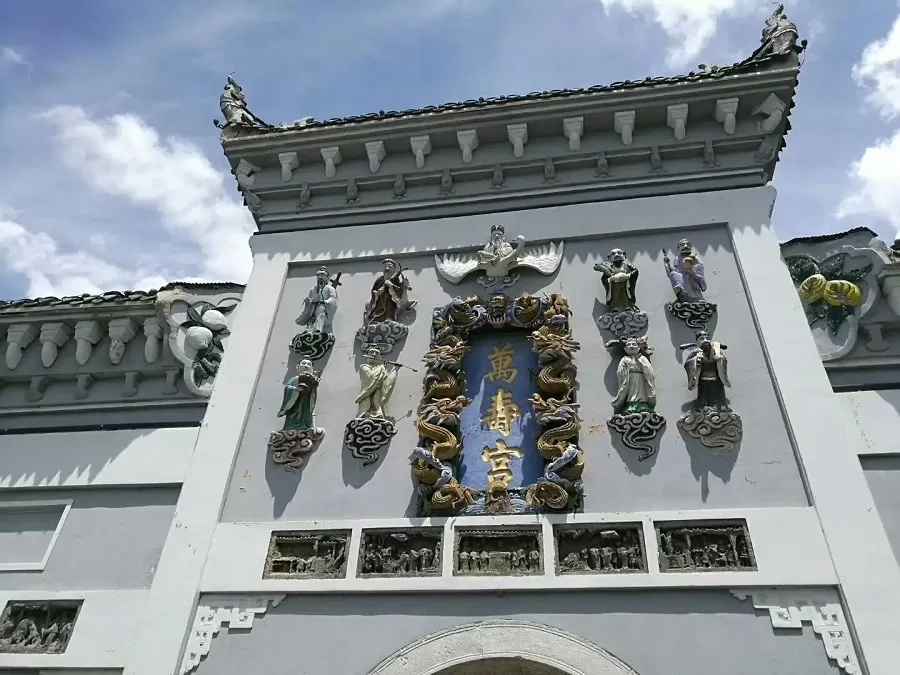
Wanshou Palace, also known as the Jiangxi Guild Hall, pays homage to Xun Zun from the Eastern Jin Dynasty. Xun Zun, born in the second year of Chiyu in Wu (239 AD) in Nanchang, Jiangxi, devoted his youth to Daoism. His exemplary conduct and reputation as a filial son led to his appointment as the Magistrate of Jingyang in Shu County. Advocating loyalty and filial piety, he benefitted the people and, after retiring, undertook the management of water control in Poyang Lake, safeguarding the livelihoods of the local populace. Revered as a deity, a temple was erected in his hometown to venerate Xun Zun after his passing.
During the Southern and Northern Dynasties, the temple’s name changed to Youwei Temple, evolving to Yulong Palace during the reign of Emperor Zhenzong of the Song Dynasty. In the era of Emperor Huizong, it transformed into Yulong Wanshou Palace, commonly known as “Wanshou Palace.” This cultural hub gradually became a cultural bridge for the integration of local and migrant cultures in Jiangxi, serving as a religious focal point.
Post-Ming and Qing dynasties witnessed the migration of Jiangxi residents who established over 1,400 Wanshou Palaces nationwide. Beyond religious significance, these halls became gathering places for local communities, acting as guilds for Jiangxi people in foreign regions. Additionally, during prosperous periods, they extended their influence into charitable and public welfare activities, showcasing a strong cohesive force, pioneering spirit, and a significant role in economic development.
Zhuangyuan Mansion: Home of the First Scholar in Guizhou

Zhuangyuan Mansion, located at 1 Zhuangyuan Street, represents the residence of Zhao Yijiong, Guizhou’s first scholar. Nestled at the intersection of Zhuangyuan Street and Beijie, with the southern section known as “Xiayuan Street,” finding the mansion is facilitated by directional signs along Beijie’s main thoroughfare.
This mansion, facing south, features a two-entry, four-courtyard layout in the style of a double-eaved mountain-shaped roof, covering an approximate area of 700 square meters. The surviving structures include the front hall, main hall, two side halls, and the ceremonial gate. Inside the ceremonial gate, numerous remnants of the character “寿” (longevity) are visible on the walls, believed to be left by Zhao Yijiong’s great-great-grandfather, Zhao Lilun, when he reached a hundred years of age.
Constructed primarily with wooden elements, the mansion exudes an elegant and understated ambiance, embodying a scholarly and tranquil atmosphere that resonates with the essence of literature. As the home of Guizhou’s first scholar, Zhuangyuan Mansion stands as a testament to the intellectual legacy and cultural heritage of Qingyan Ancient Town.
North Gate (Xuanwu Gate): Symbol of Authority and Historical Significance

The North Gate, also known as Xuanwu Gate, stands as an architectural marvel with its double-eaved gable roof and traditional wooden structure. The roof, adorned with blue-gray tiles and intricate mud sculptures on the ridges, served as the venue for imperial decrees issued by envoys during ancient times. Initially built during the Tianqi era of the Ming Dynasty (1621-1624), it underwent transformation during the Qing Dynasty. In the seventeenth year of the Shunzhi era (1660), Ban Lin Gui’s son, Ying Shou, took charge and replaced the earthen city walls with stone fortifications. Further expansion and renovation took place in the third year of the Jiaqing era (1789), orchestrated by Yuan Dapeng, a scholar in military studies. The North Gate now proudly stands as one of the symbolic landmarks of Qingyan Ancient Town.
Diverse Temples: Spiritual Sanctuaries
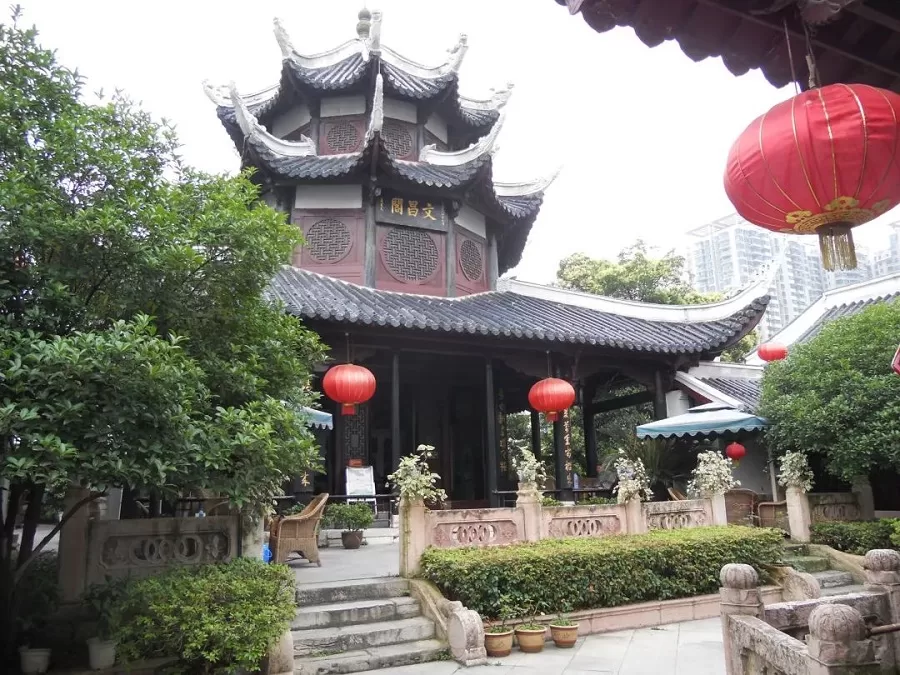
Qingyan Ancient Town is home to a myriad of temples, each with its unique historical and architectural significance. Some notable ones include:
- Ci Yun Temple: Located at 5 Beijie, Ci Yun Temple traces its origins to the Kangxi era of the Qing Dynasty, with a reconstruction in the twelfth year of the Daoguang era (1832). Encompassing an area of nearly 2000 square meters, the temple is said to have been funded by the Wu family of Xijie Street. The well-preserved architectural framework includes numerous stone pillars, showcasing exquisite stone carving artistry.
- Wen Chang Ge (Wenchang Pavilion): Situated at 143 Dongjie Street, covering an area of over 800 square meters, Wen Chang Ge dates back to the Wanli era of the Ming Dynasty, with reconstruction during the Qianlong era. Characterized by its brick and wood structure built against the mountainside, it follows the octagonal style with upturned eaves. This was a gathering place for scholars in the past, where they would study, meet, and pay homage to the god of literature, Wen Chang Di Jun.
- Ying Xiang Temple: One of the ancient Buddhist temples in Guiyang, Ying Xiang Temple was established in the first year of the Tianqi era of the Ming Dynasty (1621). With three main halls dedicated to different deities, it consists of the Heavenly King Hall in the front, the Main Hall for the Great Buddha, and the Guanyin Hall at the rear. Interestingly, atop the Guanyin Hall, there is an image of “Dou Mu,” a deity with three eyes, four heads, and eight arms from Daoist lengeds, reflecting the harmonious coexistence of Buddhism and Daoism in the region.
Folk Culture: Lively Celebrations and Unique Traditions

Qingyan Ancient Town comes alive with vibrant folk celebrations throughout the year. During the lunar New Year, activities like dragon dancing, lantern displays, and Miao ethnic group performances from the 9th to the 20th day of the first lunar month create a lively atmosphere. Other notable events include the “Yue Bai Bing” celebration on the fifth day of the fifth lunar month and the Guanyin Festival on the nineteenth day of the second and ninth lunar months.
A unique highlight during festivals is the display of a type of small fireworks known as “Shui Haozi” or water mice. These are meticulously crafted by layering paper, painting eyes, noses, and ears in various colors. The structure is then sealed with wax, containing layers of gunpowder and grid powder, connected with a fuse. When ignited and placed on a calm water surface, the water mouse dances, alternately diving and resurfacing, resembling a lively rodent. This delightful tradition adds an extra layer of charm to the festivities, showcasing the creativity and liveliness of Qingyan’s folk culture.
Vlog about Qingyan Ancient Town
Consejos útiles resumidos a partir de reseñas
Local Cuisine Recommendations:
- Braised Pig’s Trotters (卤猪脚): Known as “Zhuang Yuan Ti,” these braised pig’s trotters are a must-try in Qingyan Ancient Town. Tender and flavorful, they symbolize success and are available in many eateries throughout the town.
- Gao Ba Xifan (糕粑稀饭): This traditional sweet dish is a local delicacy and is considered intangible cultural heritage in Guiyang. It’s a warm and comforting dessert, perfect for trying during your visit.
- Rice Tofu (米豆腐): Made from vegetable juice, Qingyan’s rice tofu has a vibrant green color and can be enjoyed cold as a salad or grilled or fried for different textures.
- Tofu Balls (豆腐圆子): These fried tofu balls are crispy on the outside and tender on the inside, filled with a savory mixture of chili peppers and other ingredients. They offer a unique and rich flavor.
- Spicy Chicken Cubes (辣鸡角): Coated in spicy chili sauce, these crispy chicken cubes are incredibly flavorful and make for a perfect accompaniment to rice. They also serve as great souvenirs to take home.
Commercialization: While Qingyan Ancient Town has become somewhat commercialized, it still maintains its charm without feeling overly touristy. Embrace the lively atmosphere and enjoy the local culture and cuisine.
Layout and Exploration: The town follows a north-south axis layout, with the main attractions located along the central road and in the alleys branching off from it. Most of the sights are situated along the main road or in adjacent alleys.
Otras atracciones del distrito de Huaxi
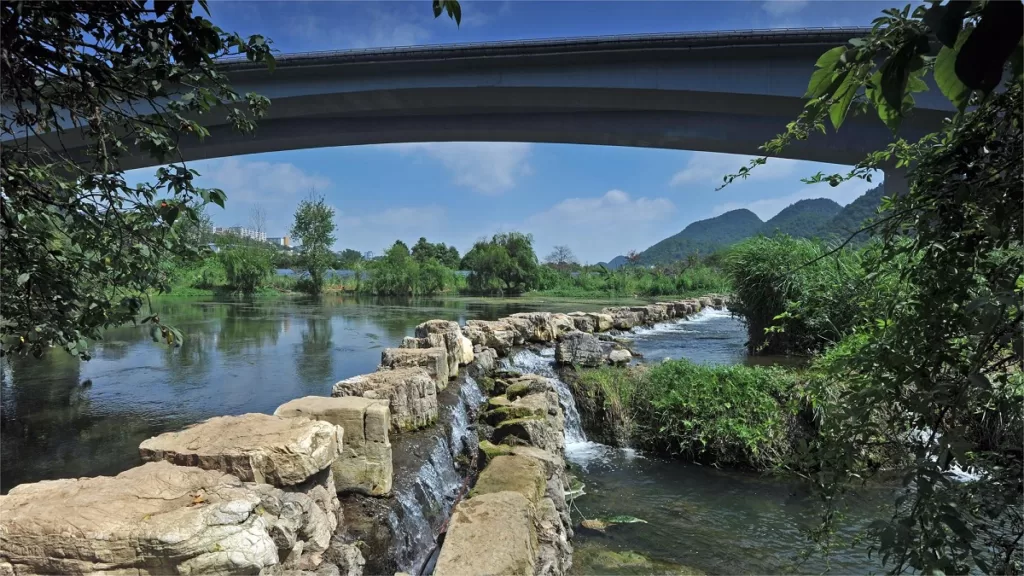
Parque Nacional del Humedal Urbano de Huaxi

Pueblo étnico de Zhenshan

Academia Confucio de Guiyang
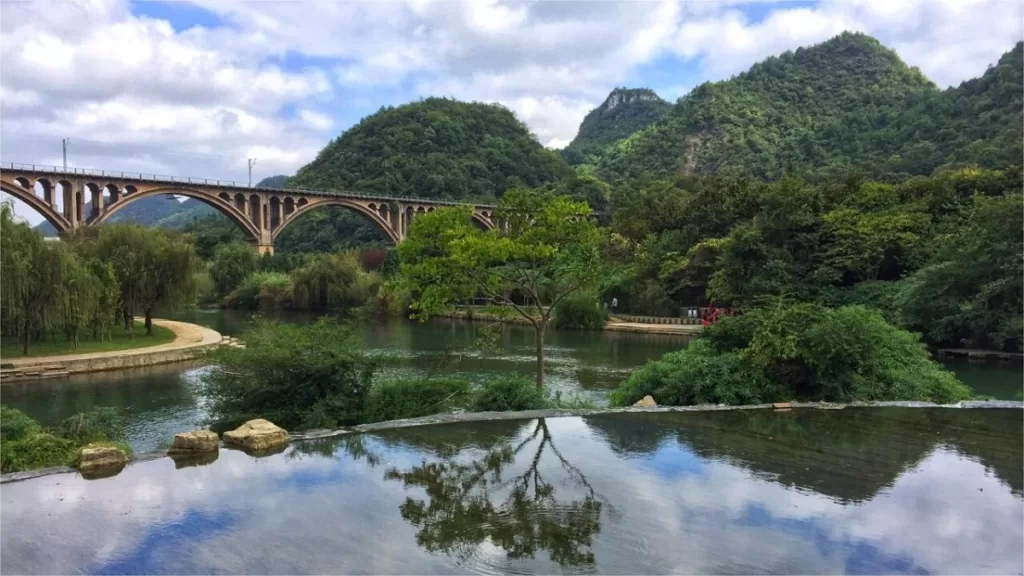
Parque Huaxi

Zona panorámica de la piscina Tianhe

Valle de Huaxi Yelang
Atracciones de Guiyang, Lugares históricos de Guizhou